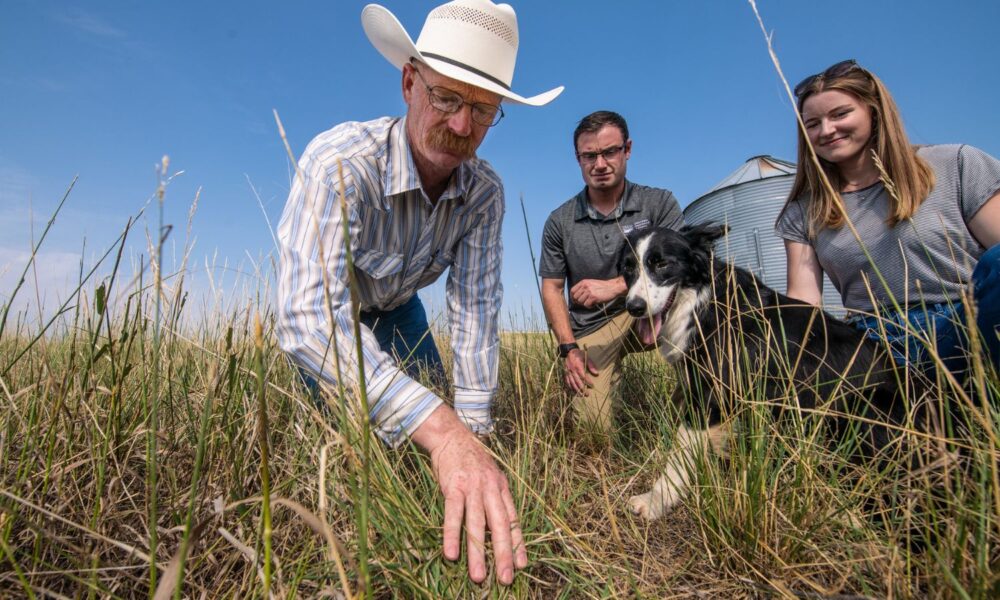Here at the Union of Concerned Scientists (UCS), we started referring to the period between June and October in the Northern hemisphere as “Danger Season” in 2022. But summer 2023 was when the climate crisis got real for a lot of people. We all felt some impact of it—blistering heat, unprecedented flooding, oppressive wildfire smoke, extreme drought, or some combination—and farmers and farm workers felt the effects in particularly damaging ways.
As farmers and farm workers recover from a growing season that NASA named the hottest on record (even as it may be among the coolest we’ll see going forward), we need to talk about what lawmakers can do about it in legislation they’re drafting right now.
The Inflation Reduction Act is directing $20B toward climate-resilient agriculture
Reducing heat-trapping carbon dioxide (CO2) emissions through policies that drive renewable energy and clean transportation has well known benefits. Last year’s Inflation Reduction Act (IRA) made historic investments to speed the decarbonization of these sectors. My colleagues (including this climate scientist just named to the TIME100 Next list of the world’s rising leaders!) advocated long and hard for the IRA’s investments in renewable energy sources and clean vehicles, and UCS continues to work to maximize the benefits of those investments.
But the IRA also included a lesser known—yet equally historic—investment to boost the potential for US agriculture to be part of the climate solution while simultaneously becoming more resilient in the face of a changing climate. At nearly $20 billion over five years, it’s the largest investment in conservation on farms since the Dust Bowl of the 1930s, and it’s focused on helping farmers shift the ways they manage their land in order to better adapt to our new climate reality.
The US Department of Agriculture (USDA) has estimated that these dollars will help hundreds of thousands of farmers and ranchers apply conservation to millions of acres of land. This investment is badly needed, as extreme weather fueled by climate change demonstrated during summer 2023. Flooding, excessive heat, and drought wreaked havoc on farms and ranches around the country, from California to Texas to Massachusetts.
Of course, the problem is much bigger than this past summer. Flood- and drought-related damage to crops and livestock have been on the rise for years, and so have the costs of these disasters, which are often borne by taxpayers through the National Crop Insurance Program. That program subsidizes a portion of an eligible farmer’s insurance premium, and then also pays the farmer for claims when losses occur. With the increasing frequency and severity of extreme weather events—and related increasing interest in the insurance program—the costs of that program from less than $3 billion in 2002 to more than $19 billion in 2022.
The old adage about doing the same thing over and over again and expecting a different result is apt here. We can choose, as a nation, to continue with business as usual and watch the cost of disasters pile up—for all of us as consumers and taxpayers—or we can take steps to help farmers adapt and prevent some of the future damage. Just as changes in urban planning and coastal development can build resilience to climate impacts, so too can changes in agriculture.
Back when the IRA passed, I summarized how its investments would help farmers do this by boosting funding for a variety of existing USDA conservation programs that underwrite the costs farmers can incur when they adopt soil-protecting, pollution-reducing, climate-friendly practices. Such practices, which include cover crops, deep-rooted perennial crops and buffer strips, and smart grazing systems, have been shown to buffer farmland from some of the damage caused by both floods and droughts. These practices work by making soil spongier so it soaks up more water during heavy rains and holds more moisture through dry periods.
The USDA’s conservation incentives programs have long been oversubscribed, helping many farmers but often turning away many more for lack of funds. Expansion of these program with IRA funds in the law’s first year is indeed attracting record interest (so much so that demand is again outstripping available dollars).
Voters agree, Congress should invest more in climate-focused conservation on farms
In addition to their popularity with farmers, the incentives in the programs funded by the IRA are popular with voters, as recent polling commissioned by UCS in summer 2023 showed. Large majorities of voters in four states and nationwide see crop failures from extreme weather as a threat to their state. Overwhelming majorities—84% in Georgia, 85% in Colorado, 88% in Pennsylvania, and a whopping 90% in Michigan—say further that they support programs that help farmers proactively adapt and protect their land and crops against flooding and drought.
Farmers and their communities, and even people living far from farming, agree on the value of these investments because they deliver multiple benefits. As above, they offer a way to bring down the costs of weather disasters on farms and protect our food supply. This, in turn, can help lessen the price shocks that can result when crop and livestock losses occur.
In addition, the same practices that turn farm soils into sponges also pull more carbon from the atmosphere into the soil, making farmers part of the solution to worsening climate change. This is good for all of us, of course. But it is specifically good for farmers and the people they employ, who as outdoor workers are already at risk from dangerous heat, wildfire smoke, and other climate hazards, and whose working conditions will be untenable without economy-wide action to limit warming.
It is agriculture’s responsibility to be part of that action. Today, as changes in energy and transportation sector bring down those sectors’ emissions, agriculture could soon become the nation’s leading source of heat-trapping gases.
Agribusiness lobby and climate-denying lawmakers are working to reverse climate progress
Back to what Congress must do now:
Funding from the IRA is already working to build climate resilience and store more carbon on more farm acres, but we can’t just celebrate, because some in Congress are looking to reverse that progress. These are lawmakers with a history of climate denial and strong ties to the big agribusiness corporations that have hijacked our food and farm system and that lobby hard to maintain their grip on the system. They aren’t interested in conceding the climate crisis and changing the status quo.
Having sought ways to repeal and undo other parts of the IRA earlier this year, now some of these members of Congress are looking for ways to use the next food and farm bill to claw back climate-focused IRA funding and direct it to other priorities.
One proposal has been to use the money to raise what are known as “reference prices,” which guarantee that commodity farmers will bring in minimum prices for their products and trigger government payments if market prices drop lower. Experts at the Environmental Working Group (EWG) have spent decades examining the flow of taxpayer money into these payments for big agricultural commodities, and the resulting detrimental effects. An EWG analysis in July showed that raising these price guarantees would be good for just a small minority of the nation’s farmers.
Senate Republicans have also proposed to use IRA funds for what they call “traditional conservation”…which, ironically, could include projects that prop up some of the largest industrial-scale meat and dairy operations that actually make climate change worse.
In the face of these attempts to effectively roll back the IRA’s progress, Senate agriculture committee chairwoman Sen. Debbie Stabenow has vowed to maintain the climate-focused $20 billion for its intended purpose (paywall), and that’s good. Maintaining a climate focus is critical to tackling the existential crisis of our time.
We must protect our investments in climate action and resilience
Follow me on a little tangent here to explore a case study in targeted public policies from another area of the US food system: child nutrition.
In 2010, Congress passed the Healthy Hunger-Free Kids Act, on a bipartisan basis, to overhaul federally subsidized school lunch programs and improve children’s health and educational outcomes. Among the requirements was that school meals needed to incorporate increasing amounts of whole grains, a dietary shift associated with improved health outcomes. Food companies and their allies and advocates objected, of course, but then-President Obama’s USDA issued regulations, and the whole grain content of school meals gradually rose.
And guess what has happened since then? Children in this country have become the only age group in which consumption of whole grain have increased, according to a new USDA study.
Smart public policies work. You get what you invest in.
Over at President Biden’s USDA, the agriculture secretary is calling on stakeholders to demand that Congress protect and maintain the IRA’s investments for climate action and resilience. A few weeks ago, Secretary Vilsack told progressive farmers from the National Farmers Union, “it’s up to you” to lobby Congress to preserve the IRA’s gains.
Scientists and the rest of us must also weigh in. Earlier this year, UCS was among more than 600 conservation, farming, and agriculture organizations, farms, food companies, and businesses that sent a letter urging congressional leaders to ensure that the upcoming food and farm bill safeguards the IRA’s investments in climate-smart agriculture and conservation.
Make your own voice heard here. Do it today.

